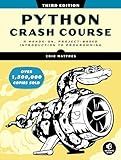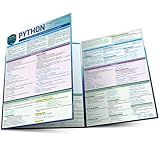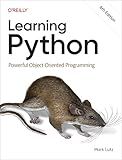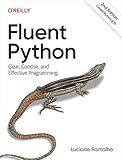Best Python Data Visualization Tools to Buy in December 2025

Python Crash Course, 3rd Edition: A Hands-On, Project-Based Introduction to Programming



Python Programming for Beginners: The Complete Python Coding Crash Course - Boost Your Growth with an Innovative Ultra-Fast Learning Framework and Exclusive Hands-On Interactive Exercises & Projects



Python Programming Language: a QuickStudy Laminated Reference Guide



Learning Python: Powerful Object-Oriented Programming



Python 3: The Comprehensive Guide to Hands-On Python Programming (Rheinwerk Computing)



Python Programming: An Introduction to Computer Science, Fourth Edition



Fluent Python: Clear, Concise, and Effective Programming



Automate the Boring Stuff with Python, 2nd Edition: Practical Programming for Total Beginners
- LEARN PYTHON THROUGH PRACTICAL PROJECTS FOR TOTAL BEGINNERS!
- HIGH-QUALITY MATERIAL ENSURES A DURABLE AND ENJOYABLE READING EXPERIENCE.
- AUTOMATE EVERYDAY TASKS EASILY AND BOOST YOUR PRODUCTIVITY!



Python All-in-One For Dummies (For Dummies: Learning Made Easy)


To add a plot to a figure in Matplotlib, you can follow these steps:
- Import the necessary libraries:
import matplotlib.pyplot as plt import numpy as np
- Create a figure and an axis:
fig, ax = plt.subplots()
- Generate some data points to plot:
x = np.linspace(0, 10, 100) y = np.sin(x)
- Add the plot to the axis:
ax.plot(x, y)
You can customize the plot by specifying various parameters inside the plot function, such as line style, color, and markers.
- Add labels to the x-axis and y-axis:
ax.set_xlabel('X-axis') ax.set_ylabel('Y-axis')
- Add a title to the figure:
ax.set_title('Plot Example')
- Display the figure:
plt.show()
These steps demonstrate a basic way to add a plot to a figure in Matplotlib. By exploring the official Matplotlib documentation, you can find more advanced plotting techniques and customization options to enhance your plots further.
What are the different types of markers available in Matplotlib?
There are multiple types of markers available in Matplotlib. Some of the commonly used marker types include:
- "." - Point marker (dot)
- "," - Pixel marker
- "o" - Circle marker
- "v" - Triangle_down marker
- "^" - Triangle_up marker
- "<" - Triangle_left marker
- ">" - Triangle_right marker
- "1" - Tri_down marker
- "2" - Tri_up marker
- "3" - Tri_left marker
- "4" - Tri_right marker
- "8" - Octagon marker
- "s" - Square marker
- "p" - Pentagon marker
- "P" - Plus (filled) marker
- "*" - Star marker
- "h" - Hexagon1 marker
- "H" - Hexagon2 marker
- "+" - Plus marker
- "x" - X marker
- "X" - X (filled) marker
- "D" - Diamond marker
- "d" - Thin diamond marker
- "|" - Vline marker
- "_" - Hline marker
These markers can be selected and customized while plotting data points on a graph using Matplotlib.
How to create a scatter plot matrix in Matplotlib?
To create a scatter plot matrix in Matplotlib, you can use the scatter_matrix() function from the pandas.plotting module. Here is an example code that demonstrates how to create a scatter plot matrix:
import pandas as pd import matplotlib.pyplot as plt from pandas.plotting import scatter_matrix
Create a DataFrame with some sample data
data = pd.DataFrame({'A': [1, 2, 3, 4], 'B': [5, 6, 7, 8], 'C': [9, 10, 11, 12], 'D': [13, 14, 15, 16]})
Create a scatter plot matrix
scatter_matrix(data, alpha=0.8, figsize=(6, 6), diagonal='kde')
Show the plot
plt.show()
In the code above, we first create a DataFrame data with some sample data. Then we use scatter_matrix(data) to create a scatter plot matrix. The alpha parameter controls the transparency of the markers, the figsize parameter sets the size of the plot, and the diagonal parameter specifies what kind of plots to show along the diagonal. In this example, we use 'kde' to show kernel density estimation plots. Finally, we call plt.show() to display the plot.
How to change the line style in a Matplotlib plot?
To change the line style in a Matplotlib plot, you can use the linestyle parameter in the plot() function. Here are the steps:
- Import the required libraries:
import matplotlib.pyplot as plt
- Create some data for the x and y axes:
x = [1, 2, 3, 4, 5] y = [2, 4, 6, 8, 10]
- Specify the line style using the linestyle parameter:
plt.plot(x, y, linestyle='--')
Here, linestyle='--' sets the line style to dashed. You can change it to other styles like '-' for solid, ':' for dotted, or '-.' for dash-dot. 4. Display the plot using plt.show():
plt.show()
The complete code would look like this:
import matplotlib.pyplot as plt
x = [1, 2, 3, 4, 5] y = [2, 4, 6, 8, 10]
plt.plot(x, y, linestyle='--') plt.show()
Running this code will display a line plot with a dashed line style.
How to add markers to a line graph in Matplotlib?
To add markers to a line graph in Matplotlib, you can use the marker parameter of the plot() function. Here is an example code that demonstrates this:
import matplotlib.pyplot as plt
Data
x = [1, 2, 3, 4, 5] y = [1, 3, 2, 4, 5]
Plot the line graph with markers
plt.plot(x, y, marker='o')
Add labels and title
plt.xlabel('x-axis') plt.ylabel('y-axis') plt.title('Line graph with markers')
Show the graph
plt.show()
In this example, marker='o' adds circular markers to the data points. You can use different marker styles, such as 'o' for circles, 's' for squares, or 'x' for crosses. You can also specify the size and color of the markers using additional parameters like markersize and markerfacecolor.
Note that you need to have Matplotlib installed in order to run this code.
What is Matplotlib used for?
Matplotlib is a popular data visualization library used in Python. It is used for creating various types of plots and charts, including line plots, scatter plots, bar plots, histograms, pie charts, and more. It provides a flexible and user-friendly interface to visualize data and display it in a visually appealing and informative manner. Matplotlib is widely used in scientific research, data analysis, and machine learning to explore and understand patterns, trends, and relationships in data.
How to set x-axis and y-axis labels in Matplotlib?
To set the x-axis and y-axis labels in Matplotlib, you can use the xlabel() and ylabel() functions respectively. Here is an example:
import matplotlib.pyplot as plt
Generate some example data
x = [1, 2, 3, 4, 5] y = [2, 4, 6, 8, 10]
Plot the data
plt.plot(x, y)
Set the x-axis label
plt.xlabel('X-axis')
Set the y-axis label
plt.ylabel('Y-axis')
Display the plot
plt.show()
In this example, the xlabel() function is used to set the x-axis label to 'X-axis', and the ylabel() function is used to set the y-axis label to 'Y-axis'.
You can also customize the labels by adding additional parameters to these functions. For example, you can specify the color, font size, and font weight of the labels.
